Brazil Agricultural Irrigation Machinery Market Size
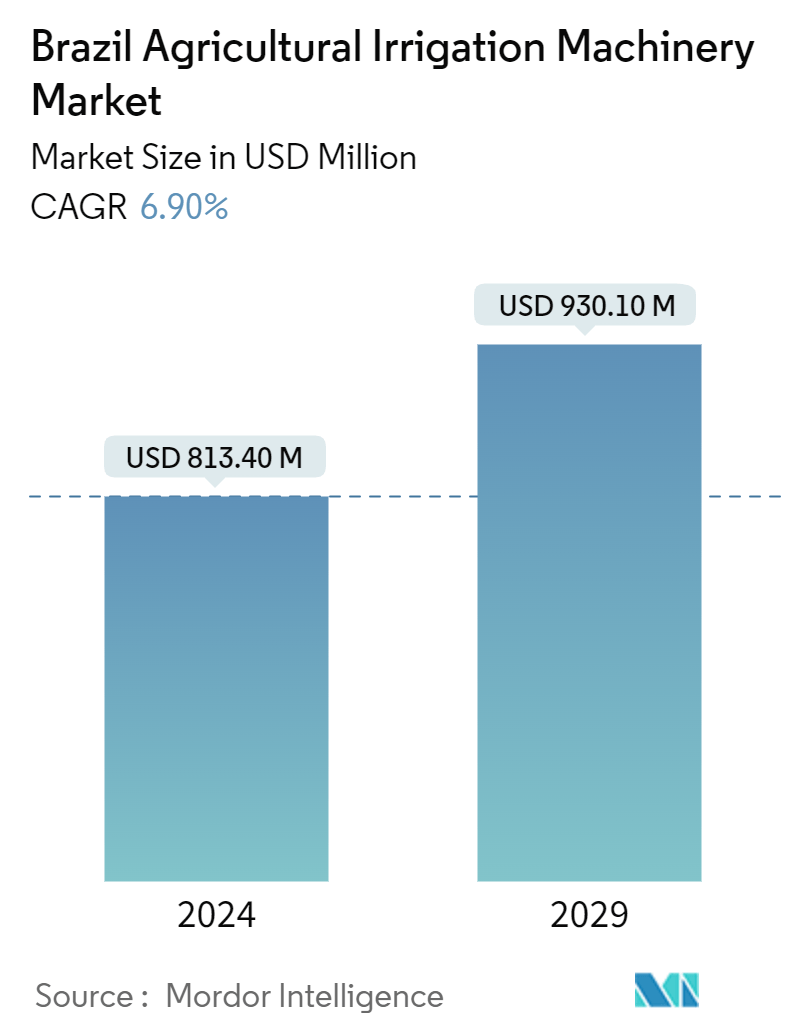
| Study Period | 2019 - 2029 |
| Base Year For Estimation | 2023 |
| Market Size (2024) | USD 813.40 Million |
| Market Size (2029) | USD 930.10 Million |
| CAGR (2024 - 2029) | 6.90 % |
| Market Concentration | High |
Major Players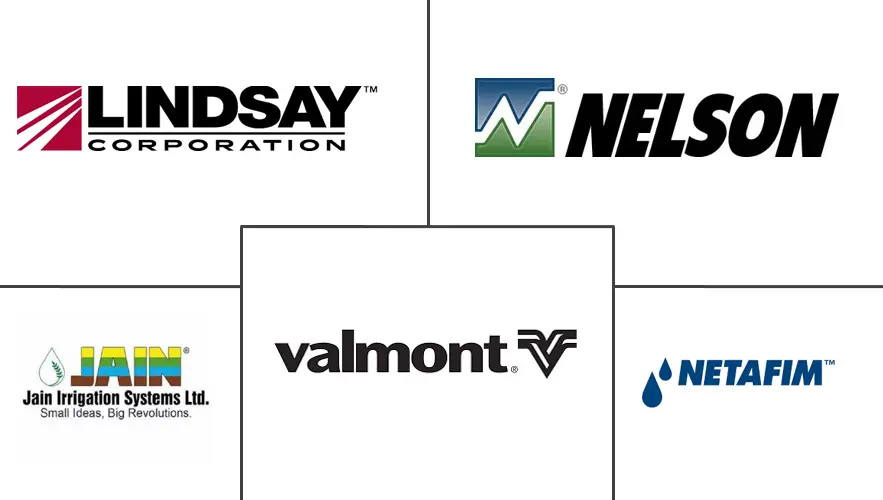
*Disclaimer: Major Players sorted in no particular order |
Brazil Agricultural Irrigation Machinery Market Analysis
The Brazil Agricultural Irrigation Machinery Market size is estimated at USD 813.40 million in 2024, and is expected to reach USD 930.10 million by 2029, growing at a CAGR of 6.90% during the forecast period (2024-2029).
- Irrigation Machinery is effective in improving agricultural yields without consuming an excessive amount of water, preventing soil erosion and reducing water waste. Among various types of irrigation systems, drip irrigation is the most prevalent system in the country, whereas the pivot irrigation system is growing at the fastest pace. The fruits and vegetables segment is the leading segment utilizing irrigation systems.
- There has been an increasing adaptation of irrigation machinery in the country due to growing governmental concerns regarding water management for irrigation purposes, accompanied by the growing interest of stakeholders in accelerating production output. Also, irrigation machinery has been created to operate various crops, including orchard crops, cereals, and oilseeds. The use of drip and sprinkler irrigation systems in agriculture is growing. The trend of the increasing installation of irrigation systems in the country would continue, considering the popularity of Brazil-based fruits and vegetables in local and international markets.
- Further, the government has encouraged farmers to adopt automated machinery to enhance crop production. In 2021, Brazil launched its farm subsidies funding bill, called the 'crop plan' locally. The total budget for the program was increased by 6.1%, which accounted for USD 44.2 billion, and USD 10.6 billion of that is allocated for subsidized loans for agricultural systems. These initiatives encourage Brazilian farmers to adopt advanced irrigation equipment, including drip, for better crop production.
- The international authorities also have leaned financial support to boost smart agricultural techniques in Brazil, which has also favored the growth of drip irrigation. For instance, in 2022, IFC, a member of the World Bank Group, supported the renewal of sugarcane plantations, utilizing innovative and climate-smart agricultural techniques to mitigate climate risks with a financial package of USD 50 million. The program relies on implementing efficient micro-irrigation systems, including drip irrigation systems.
Brazil Agricultural Irrigation Machinery Market Trends
The Drip Irrigation Segment is Expected to Dominate the Market
Ensuring a stable food supply in the context of increasing extreme climate events is a major global challenge to achieving the Agenda 2030 goals in Brazil. As one of the main producers and exporters of agricultural products, Brazil is committed to providing healthy and nutritious food to meet national and global food security. For instance, according to ITC Trade Map data, Brazil's export of corn was 43,389,352 metric tons in 2022, which increased to 55,893,042 metric tons in 2023. Consequently, agricultural machinery like drip irrigation can help achieve the desired productivity results. Farmers or producers may fail to notice, but there can be constant frustrations of harvests and compromised crop quality due to incrustation and obstruction problems of the emitters. This can unbalance the irrigation machinery and fail to supply the plants with water and nutrients correctly. Hence, when stakeholders incorporate suitable agriculture irrigation machinery, it helps achieve the required output.
The benefits of drip irrigation are mostly seen in large, cropped areas, usually operated by major companies. Over the years, the number of small-scale farmers that use drip irrigation has increased as the commercial benefits outweigh the initial investment cost. Some of the crops that are cultivated using drip irrigation systems are coffee, sugar, and soya beans. The regions in Brazil that extensively use modern irrigation systems for cultivation are Parana, Rio Grande Do Sul, Sao Paulo, Mato Grosso Du Sul, Goias, and Ninas Gerais. Even with local water conditions from water in the So Francisco River and the AQUA4D irrigation system, incredible productivity results were obtained in grape production with water treatment incorporated into the system. Growers in the Sao Francisco Valley were able to produce exceptional results. The area had a 27% boost in productivity and a 14% increase in the quality of the production. Even other crops growing in Brazil, like horticultural greenhouse products, have received desired productivity results after the use of innovative irrigation machinery.
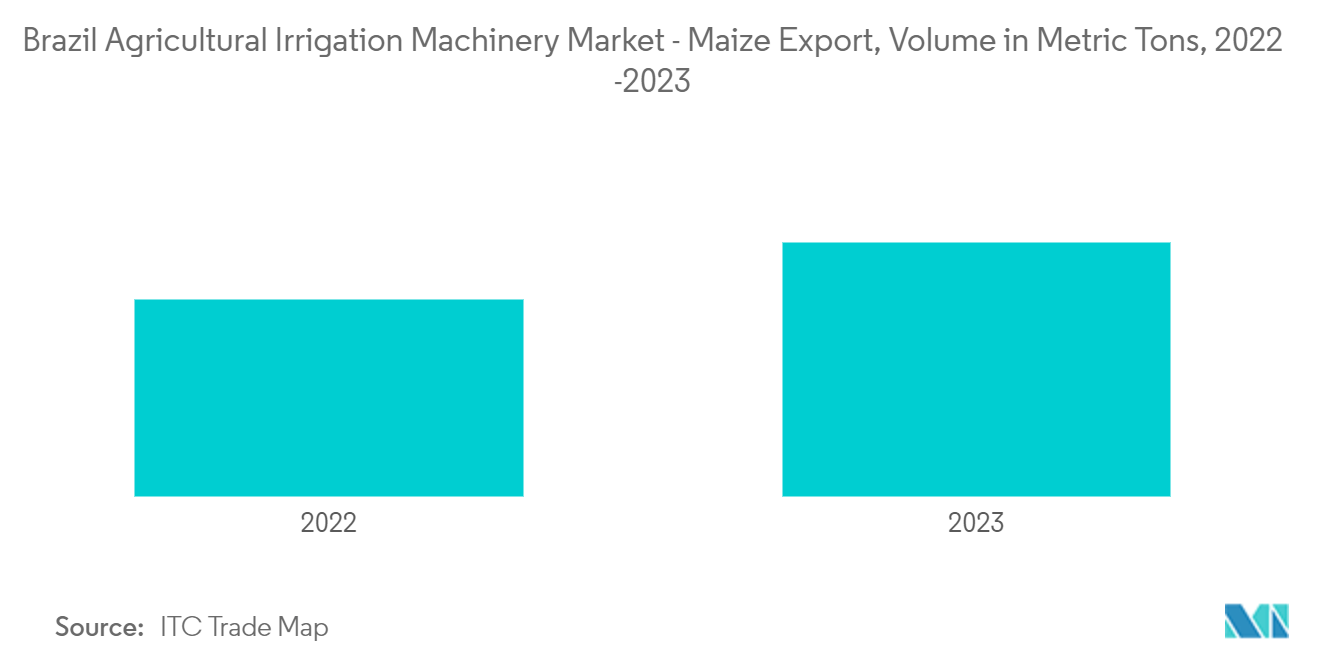
Coffee Holds a Significant Share by Crop Type Due to Increasing Demand
Brazil is the world's largest coffee producer and produces around 25% of the world's coffee. Brazil has improved its irrigation systems, and farmers have added new species of coffee to revive agriculture in the region and overcome a devastating drought in recent years. According to the FAOSTAT database, the production of coffee in the country grew from 2,985,581 tons in 2021 to 3,172,562 tons in 2022, owing to the demand for coffee in the domestic and international markets. The Brazilian organizations developed technological solutions for the use of water in coffee crops, which, in addition to streamlining the use of water, contributed to optimizing productivity and product quality and reduced production costs. Such technologies, like efficient irrigation machinery, increased coffee farmers' income. Thus, adopting irrigation types like drip irrigation has increased sales of irrigation machinery in the country. This, in turn, would boost the overall agricultural irrigation machinery market.
Further, drip irrigation machinery is the most efficient method of irrigating, particularly for Brazilian agriculture, considering the types of crops grown in the country accompanied by water scarcity prevailing in the country. Coffee is one of the major crops cultivated in Brazil. The profitability index of the conventional irrigation systems used for coffee production is much lower than that of the drip-irrigated production system. The increasing scarcity of fresh water in arid and semi-arid regions has driven the necessity of applying strategies that can save water without impacting crop yields. Thus, most crops like coffee are covered under this machinery system in the country.
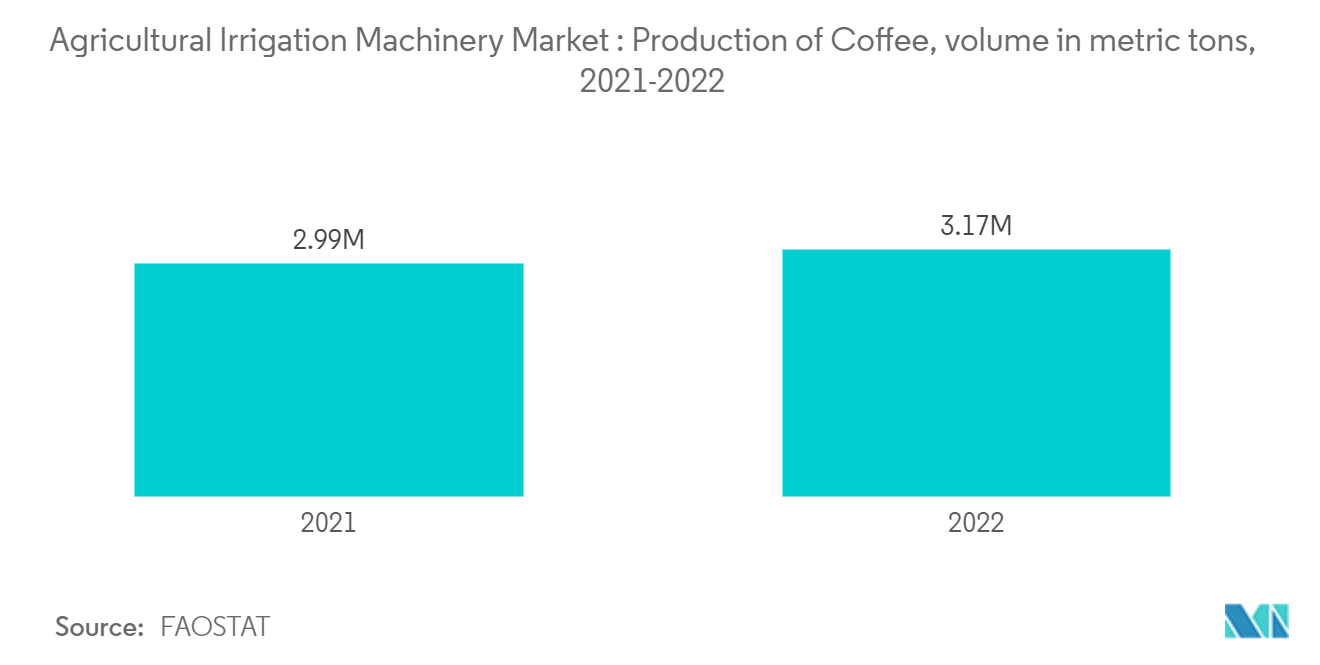
Brazil Agricultural Irrigation Machinery Industry Overview
The Brazilian agricultural irrigation machinery market is consolidated and is dominated by major manufacturers since farmers prefer international companies for assurance of quality and after-sales services offered by big companies. The drive of water conservation efforts in the country is propagating the sales of micro-irrigation systems, which are estimated to witness substantial growth shortly. This is likely to benefit major companies, such as Nelson Irrigation, Netafim, Jain Irrigation Systems Ltd, Valmont Industries, and Lindsay Corporation.
Brazil Agricultural Irrigation Machinery Market Leaders
-
Nelson Irrigation
-
Netafim
-
Jain Irrigation Systems Ltd.
-
Valmont Industries
-
Lindsay Corporation
*Disclaimer: Major Players sorted in no particular order
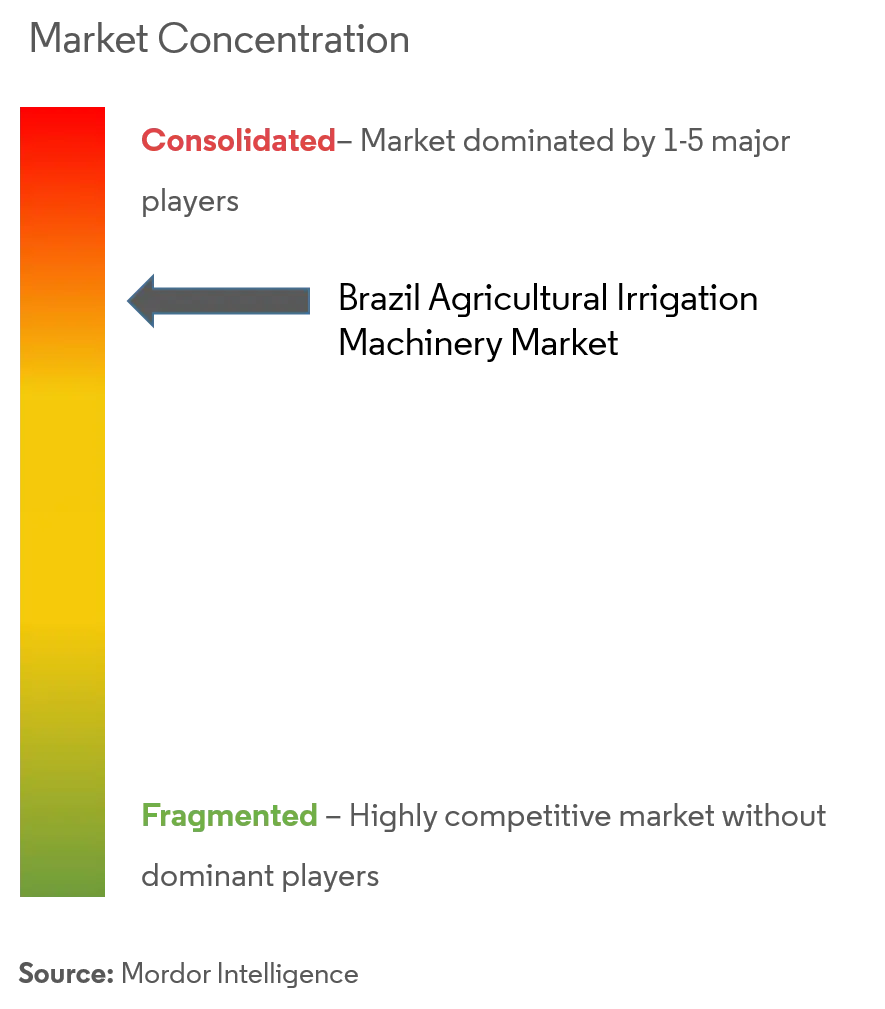
Brazil Agricultural Irrigation Machinery Market News
- May 2023: JCN Group Farms partnered with Valmont Industries for sustainable farming practices to conserve valuable resources while meeting food demand. Photovoltaic (PV) arrays are being installed to use solar energy to power irrigation systems across more than 8,000 acres (3,237 hectares) of farmland due to high energy costs and looming drought across Brazil.
- October 2022: NaanDanJain partnered with BASF to combine crop protection, seeds, and digital portfolio with advanced irrigation technology from NaanDanJain, ensuring crop management and optimized use of water resources. The pilot project is in the Cerrado region of Brazil, contributing to responsible agricultural production in the region.
Brazil Agricultural Irrigation Machinery Market Report - Table of Contents
1. INTRODUCTION
- 1.1 Study Assumptions and Market Definition
- 1.2 Scope of the Study
2. RESEARCH METHODOLOGY
3. EXECUTIVE SUMMARY
4. MARKET DYNAMICS
- 4.1 Market Overview
-
4.2 Market Drivers
- 4.2.1 Rising Problem of Water Scarcity in Brazil
- 4.2.2 Increasing Agricultural Output is Driving the Adoption of Irrigation Machinery
- 4.2.3 Government Initiatives Fuel Growth in the Brazilian Irrigation Systems Market
-
4.3 Market Restraints
- 4.3.1 Damage Caused to Irrigation System Set-up Due to Hard Water Supply in Brazil
- 4.3.2 High Initial Capital Investments
-
4.4 Porter's Five Forces Analysis
- 4.4.1 Threat of New Entrants
- 4.4.2 Bargaining Power of Buyers/Consumers
- 4.4.3 Bargaining Power of Suppliers
- 4.4.4 Threat of Substitute Products
- 4.4.5 Intensity of Competitive Rivalry
5. MARKET SEGMENTATION
-
5.1 Type
- 5.1.1 Sprinkler Irrigation
- 5.1.1.1 Pumping Unit
- 5.1.1.2 Tubing
- 5.1.1.3 Couplers
- 5.1.1.4 Spray/Sprinklers Heads
- 5.1.1.5 Fittings and Accessories
- 5.1.2 Drip Irrigation
- 5.1.2.1 Valves
- 5.1.2.2 Backflow Preventers
- 5.1.2.3 Pressure Regulators
- 5.1.2.4 Filters
- 5.1.2.5 Emitters
- 5.1.2.6 Tubing
- 5.1.2.7 Other Drip Irrigation Systems
- 5.1.3 Pivot Irrigation
-
5.2 Application
- 5.2.1 Crop
- 5.2.1.1 Field Crops
- 5.2.1.2 Vegetables
- 5.2.1.3 Fruits
- 5.2.2 Non-crop
- 5.2.2.1 Turf and Ornamental
6. Competitive Analysis
- 6.1 Market Share Analysis
- 6.2 Most Adopted Strategies
-
6.3 Company Profiles
- 6.3.1 Nelson Irrigation
- 6.3.2 Netafim
- 6.3.3 Jain Irrigation Systems Ltd
- 6.3.4 Valmont Industries
- 6.3.5 Lindsay Corporation
- 6.3.6 Rain Bird Corporation
- 6.3.7 Rivulis
- 6.3.8 EPC Industries Limited
- 6.3.9 Irritec SpA
- *List Not Exhaustive
7. MARKET OPPORTUNITIES AND FUTURE TRENDS
** Subject To AvailablityBrazil Agricultural Irrigation Machinery Industry Segmentation
Agricultural irrigation machinery is specified equipment and systems proposed to deliver water to agricultural fields and crops efficiently.
The Brazilian agricultural irrigation machinery market is segmented by type (sprinkler irrigation (pumping unit, tubing, couplers, spray/sprinklers heads, and fittings and accessories), drip irrigation (valves, backflow preventers, pressure regulators, filters, emitters, tubing, and other drip irrigation systems), and pivot irrigation) and application (crop type and non-crop type). The report offers the market size and forecasts regarding value (USD) for all the above segments.
| Type | Sprinkler Irrigation | Pumping Unit |
| Tubing | ||
| Couplers | ||
| Spray/Sprinklers Heads | ||
| Fittings and Accessories | ||
| Type | Drip Irrigation | Valves |
| Backflow Preventers | ||
| Pressure Regulators | ||
| Filters | ||
| Emitters | ||
| Tubing | ||
| Other Drip Irrigation Systems | ||
| Type | Pivot Irrigation | |
| Application | Crop | Field Crops |
| Vegetables | ||
| Fruits | ||
| Application | Non-crop | Turf and Ornamental |
Brazil Agricultural Irrigation Machinery Market Research FAQs
How big is the Brazil Agricultural Irrigation Machinery Market?
The Brazil Agricultural Irrigation Machinery Market size is expected to reach USD 813.40 million in 2024 and grow at a CAGR of 6.90% to reach USD 930.10 million by 2029.
What is the current Brazil Agricultural Irrigation Machinery Market size?
In 2024, the Brazil Agricultural Irrigation Machinery Market size is expected to reach USD 813.40 million.
Who are the key players in Brazil Agricultural Irrigation Machinery Market?
Nelson Irrigation, Netafim, Jain Irrigation Systems Ltd., Valmont Industries and Lindsay Corporation are the major companies operating in the Brazil Agricultural Irrigation Machinery Market.
What years does this Brazil Agricultural Irrigation Machinery Market cover, and what was the market size in 2023?
In 2023, the Brazil Agricultural Irrigation Machinery Market size was estimated at USD 757.28 million. The report covers the Brazil Agricultural Irrigation Machinery Market historical market size for years: 2019, 2020, 2021, 2022 and 2023. The report also forecasts the Brazil Agricultural Irrigation Machinery Market size for years: 2024, 2025, 2026, 2027, 2028 and 2029.
Brazil Agricultural Irrigation Machinery Industry Report
Statistics for the 2024 Brazil Agricultural Irrigation Machinery market share, size and revenue growth rate, created by Mordor Intelligence™ Industry Reports. Brazil Agricultural Irrigation Machinery analysis includes a market forecast outlook to 2029 and historical overview. Get a sample of this industry analysis as a free report PDF download.



